Papers by Rhonda Rosychuk
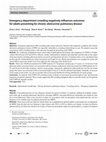
Canadian Journal of Emergency Medicine, Apr 22, 2023
Objectives Emergency department (ED) crowding leads to poor outcomes. Patients with respiratory c... more Objectives Emergency department (ED) crowding leads to poor outcomes. Patients with respiratory conditions like chronic obstructive pulmonary disease (COPD) are especially vulnerable to crowding-related delays in care. We aimed to assess the associations of ED crowding metrics with outcomes for patients presenting with COPD. Methods We conducted a population-based cohort study of adult patients presenting with a diagnosis of COPD to 18 highvolume EDs between 2014 and 2019 in Alberta, Canada. Administrative databases provided date and time data on key stages of the presentation including physician initial assessment and disposition decision. Crowding metrics were calculated using facility-specific median physician initial assessment and length of stay. Patient presentations were grouped by acuity and mixed-effects regression models were fit to adjust for the clustering at the facility level. Results There were 49,085 presentations for COPD made by 25,734 patients (median age = 73 years). A 1-h increase in the physician initial assessment metric was associated with an increase in physician initial assessment for COPD patients by 23, 53, and 59 min for the high, moderate, and low acuity groups, respectively, adjusted for other predictors. For the low acuity group, this metric was associated with an increased length of stay of 73 min for admitted individuals. Similarly, an increase in the length of stay metric was also associated with an increased likelihood of being admitted for all acuity groups. Conclusions For patients with COPD, ED crowding results in delays in assessment increased length of stay, and increased proportion of patients admitted. These results suggest that ED crowding mitigation efforts to provide timely care for patients with COPD are urgently needed. Trial registration N/A. Objectifs L'encombrement des services d'urgence entraîne de mauvais résultats. Les patients souffrant de maladies respiratoires telles que la maladie pulmonaire obstructive chronique (MPOC) sont particulièrement vulnérables aux retards de soins liés à l'encombrement. Notre avons cherché à évaluer les associations entre les paramètres d'encombrement des services d'urgence et les résultats pour les patients présentant une MPOC. Méthodes Nous avons mené une étude de cohorte basée sur la population de patients adultes se présentant avec un diagnostic de MPOC dans dix-huit services d'urgence à haut volume entre 2014 et 2019 en Alberta, au Canada. Les bases de données administratives ont fourni des données sur la date et l'heure des principales étapes de la présentation, y compris l'évaluation
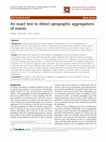
Background: Traditional approaches to statistical disease cluster detection focus on the identifi... more Background: Traditional approaches to statistical disease cluster detection focus on the identification of geographic areas with high numbers of incident or prevalent cases of disease. Events related to disease may be more appropriate for analysis than disease cases in some contexts. Multiple events related to disease may be possible for each disease case and the repeated nature of events needs to be incorporated in cluster detection tests. Results: We provide a new approach for the detection of aggregations of events by testing individual administrative areas that may be combined with their nearest neighbours. This approach is based on the exact probabilities for the numbers of events in a tested geographic area. The test is analogous to the cluster detection test given by Besag and Newell and does not require the distributional assumptions of a similar test proposed by Rosychuk et al. Our method incorporates diverse population sizes and population distributions that can differ by important strata. Monte Carlo simulations help assess the overall number of clusters identified. The population and events for each area as well as a nearest neighbour spatial relationship are required. We also provide an alternative test applicable to situations when only the aggregate number of events, and not the number of events per individual, are known. The methodology is illustrated on administrative data of presentations to emergency departments. Conclusions: We provide a new method for the detection of aggregations of events that does not rely on distributional assumptions and performs well.
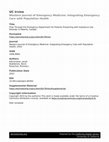
Western Journal of Emergency Medicine, Feb 15, 2013
Since 2016 the province of Alberta, Canada, has seen a significant increase in substance use diso... more Since 2016 the province of Alberta, Canada, has seen a significant increase in substance use disorder (SUD) presentations to the emergency department (ED) with a large surge during the COVID-19 pandemic. In this retrospective study we deconstruct the total length of stay (LOS) in the ED into stages for patients presenting with SUD and estimate the effects of covariates on the time to transition between stages. Methods: Using the Canadian Coding Standards for International Classification of Diseases, 10 th Modification, codes F10.0-F19.9 and T36.0-T50.9, we extracted data from the National Ambulatory Care Reporting System between April 1, 2019-March 31, 2020 on all ED presentations for SUD by Alberta residents. We used a multistate model to deconstruct the ED LOS into eight mutually exclusive states and determine which factors affected the time spent in each state. Results: We analyzed 66,880 presentations (37,530 patients). The mean age was 37.2 years, and 61% were male. The median total LOS in the ED was 6 hours 13 minutes. Patients presenting with methamphetamines (METH) intoxication and patients from low-income neighborhoods had significantly increased transition times between all states. Opposite this, opiate use was associated with faster transition times between almost all states. Metro EDs experienced slower transitions when attempting to discharge or admit patients when compared to urban or rural EDs. Emergency department crowding also had a dramatic effect on physician initial assessment times, while discharge and admission times in patients presenting with SUD were also significantly affected. Conclusion: Patients with SUD experience a variety of delays during their ED stay. Those with METH intoxication and those from the lowest income neighborhoods were most likely to experience slower transitions from state to state in the ED and may benefit from a focused approach to improve ED flow.
Journal of obstetrics and gynaecology Canada, Nov 1, 2010
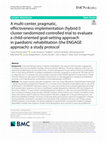
BMC Pediatrics, Jun 29, 2022
Background: Child-oriented goal-setting in pediatric rehabilitation may improve child motivation,... more Background: Child-oriented goal-setting in pediatric rehabilitation may improve child motivation, engagement in therapy, child outcomes related to therapy, and service delivery efficiency. The primary objective of this trial is to determine the effectiveness of a principles-driven, child-focused approach to goal-setting, Enhancing Child Engagement in Goal-Setting (ENGAGE), on pediatric rehabilitation outcomes compared to usual practice. The three secondary objectives are to 1) compare costs and secondary outcomes of the ENGAGE approach to usual practice, 2) determine the influence of child, parent and therapist characteristics on child engagement in therapy and rehabilitation outcomes, and 3) identify barriers and facilitators to the implementation of ENGAGE. Methods: This research protocol describes a pragmatic, multi-site, cluster, effectiveness-implementation (hybrid type 1 design) randomized controlled trial. Therapists (n = 12 clusters of two therapists) at participating sites (n = 6) will be randomized to 1) the ENGAGE intervention group, or 2) usual care (control) using a computer-generated, permutedblock randomization sequence with site as a stratification variable designed by a statistician (RR). Each therapist will recruit four children 5-12 years old with neurodevelopmental conditions (n = 96), who will receive ENGAGE or usual care, according to therapist group allocation. ENGAGE therapists will be trained to use a 'toolbox' of evidence-driven, theory-informed principles to optimize child and parent motivation, engagement in the goal-setting process, and performance feedback strategies. Outcomes include goal performance (primary outcome), engagement in therapy, functional abilities, participation, and parent and child quality of life. Qualitative interviews with children, parents, ENGAGE therapists, and managers will explore challenges to implementation and potential mitigation strategies. Mixed effects multiple linear regression models will be developed for each outcome to assess group differences
medRxiv (Cold Spring Harbor Laboratory), Jul 31, 2021
All rights reserved. No reuse allowed without permission.
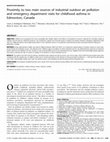
Canadian Journal of Public Health-revue Canadienne De Sante Publique, Sep 1, 2017
OBJECTIVE: Children are recognized to be more susceptible than healthy adults to the effects of a... more OBJECTIVE: Children are recognized to be more susceptible than healthy adults to the effects of air pollution; however, relatively few Canadian studies of children have focused on industrial emissions. We conducted a spatial cross-sectional study to explore associations between emergency department (ED) visits for childhood asthma and residential proximity to two industrial sources of air pollution (coal-fired power plant and petrochemical industry) in Edmonton, Canada. METHODS: Using administrative health care data for Alberta between 2004 and 2010, we conducted a spatial analysis of disease clusters of count data around these two industrial sources. The distance from children's place of residence to these industrial sources was determined by using the six-character postal code from the children's ED visit. Clusters of cases were identified at the census dissemination area. Negative binomial multivariable spatial regression was used to estimate the risks of clusters in relation to the distance to these industrial sources. RESULTS: The relative risk of ED visits for asthma, calculated using a spatial scan test for events, was 10.4 (p value <0.01) within the power plant area when compared with the outside area. In addition, there was an inverse association of the distance to the power plant (coefficient = −0.01 per km) with asthma visits when multivariable models were used. No asthma clusters were identified around the petrochemical industrial area. CONCLUSION: Our analyses revealed that there was a cluster of ED visits for asthma among children who lived near the coal-fired power plant just outside Edmonton.

BACKGROUND The accuracy of self-reported vaccination status is important to guide real-world vacc... more BACKGROUND The accuracy of self-reported vaccination status is important to guide real-world vaccine effectiveness studies and policy making in jurisdictions where access to electronic vaccine registries is restricted. OBJECTIVE This study aimed to determine the accuracy of self-reported vaccination status and reliability of the self-reported number of doses, brand, and time of vaccine administration. METHODS This diagnostic accuracy study was completed by the Canadian COVID-19 Emergency Department Rapid Response Network. We enrolled consecutive patients presenting to 4 emergency departments (EDs) in Québec between March 24, 2020, and December 25, 2021. We included adult patients who were able to consent, could speak English or French, and had a proven COVID-19 infection. We compared the self-reported vaccination status of the patients with their vaccination status in the electronic Québec Vaccination Registry. Our primary outcome was the accuracy of the self-reported vaccination st...
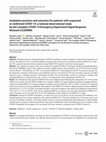
Canadian Journal of Emergency Medicine, Apr 5, 2023
Objective Intubation practices changed during the COVID-19 pandemic to protect healthcare workers... more Objective Intubation practices changed during the COVID-19 pandemic to protect healthcare workers from transmission of disease. Our objectives were to describe intubation characteristics and outcomes for patients tested for SARS CoV-2 infection. We compared outcomes between patients testing SARS COV-2 positive with those testing negative. Methods We conducted a health records review using the Canadian COVID-19 Emergency Department Rapid Response Network (CCEDRRN) registry. We included consecutive eligible patients who presented to one of 47 EDs across Canada between March 1, 2020 and June 20, 2021, were tested for SARS-CoV-2 and intubated in the ED. The primary outcome was the proportion of patients experiencing a post-intubation adverse event during the ED stay. Secondary outcomes included first-pass success, intubation practices, and hospital mortality. We used descriptive statistics to summarize variables with subgroup differences examined using t tests, z tests, or chi-squared tests where appropriate with 95% CIs. Results Of 1720 patients with suspected COVID-19 who were intubated in the ED during the study period, 337 (19.6%) tested SARS-CoV-2 positive and 1383 (80.4%) SARS-CoV-2 negative. SARS-CoV-2 positive patients presented to hospital with lower oxygen levels than SARS-CoV-2 negative patients (mean pulse oximeter SaO2 86 vs 94%, p < 0.001). In total, 8.5% of patients experienced an adverse event post-intubation. More patients in the SARS-CoV-2 positive subgroup experienced post-intubation hypoxemia (4.5 vs 2.2%, p = 0.019). In-hospital mortality was greater for patients who experienced intubation-related adverse events (43.2 vs 33.2%, p = 0.018). There was no significant difference in adverse event-associated mortality by SARS-CoV-2 status. First-pass success was achieved in 92.4% of all intubations, with no difference by SARS-CoV-2 status. Conclusions During the COVID-19 pandemic, we observed a low risk of adverse events associated with intubation, even though hypoxemia was common in patients with confirmed SARS-CoV-2. We observed high rates of first-pass success and low rates of inability to intubate. The limited number of adverse events precluded multivariate adjustments. Study findings should reassure emergency medicine practitioners that system modifications made to intubation processes in response to the COVID-19 pandemic do not appear to be associated with worse outcomes compared to pre-COVID-19 practices.

Scientific Reports
Many health authorities differentiate hospitalizations in patients infected with SARS-CoV-2 as be... more Many health authorities differentiate hospitalizations in patients infected with SARS-CoV-2 as being “for COVID-19” (due to direct manifestations of SARS-CoV-2 infection) versus being an “incidental” finding in someone admitted for an unrelated condition. We conducted a retrospective cohort study of all SARS-CoV-2 infected patients hospitalized via 47 Canadian emergency departments, March 2020-July 2022 to determine whether hospitalizations with “incidental” SARS-CoV-2 infection are less of a burden to patients and the healthcare system. Using a priori standardized definitions applied to hospital discharge diagnoses in 14,290 patients, we characterized COVID-19 as (i) the “Direct” cause for the hospitalization (70%), (ii) a potential “Contributing” factor for the hospitalization (4%), or (iii) an “Incidental” finding that did not influence the need for admission (26%). The proportion of incidental SARS-CoV-2 infections rose from 10% in Wave 1 to 41% during the Omicron wave. Patients...

Pilot and Feasibility Studies
Background Pediatric obesity management can be successful, but some families discontinue care pre... more Background Pediatric obesity management can be successful, but some families discontinue care prematurely (i.e., attrition), limiting treatment impact. Attrition is often a consequence of barriers and constraints that limit families’ access to obesity management. Family Navigation (FN) can improve access, satisfaction with care, and treatment outcomes in diverse areas of healthcare. To help our team prepare for a future effectiveness trial, the objectives of our randomized feasibility study are to (i) explore children’s and caregivers’ acceptability of FN and (ii) examine attrition, measures of study rigor and conduct, and responses to FN + Usual Care vs Usual Care by collecting clinical, health services, and health economic data. Methods In our 2.5-year study, 108 6–17-year-olds with obesity and their caregivers will be randomized (1:1) to FN + Usual Care or Usual Care after they enroll in obesity management clinics in Calgary and Mississauga, Canada. Our Stakeholder Steering Commi...
Journal of the American College of Emergency Physicians Open
Objective: To risk-stratify COVID-19 patients being considered for discharge from the emergency d... more Objective: To risk-stratify COVID-19 patients being considered for discharge from the emergency department (ED).

BACKGROUND: Pediatric obesity management can be successful, but some families discontinue care pr... more BACKGROUND: Pediatric obesity management can be successful, but some families discontinue care prematurely (i.e., attrition), limiting treatment impact. Attrition is often a consequence of barriers and constraints that limit families’ access to obesity management. Family Navigation (FN) can improve access, satisfaction with care, and treatment outcomes in diverse areas of healthcare. To help our team prepare for a future effectiveness trial, the objectives of our randomized feasibility study are to (i) explore children's and caregivers' acceptability of FN and (ii) examine attrition, measures of study rigour and conduct, and responses to FN + Usual Care vs Usual Care by collecting clinical, health services, and health economic data.METHODS: In our 2.5-year study, 108 6–17-year-olds with obesity and their caregivers will be randomized (1:1) to FN + Usual Care or Usual Care after they enroll in obesity management clinics in Edmonton, Calgary, and Mississauga, Canada. Our Stake...

Substance Abuse Treatment, Prevention, and Policy, 2022
Background Inner city patients have a higher illness burden and need for care, but experience mor... more Background Inner city patients have a higher illness burden and need for care, but experience more unmet care needs. Hospital Addiction Medicine Consult Teams (AMCTs) are a promising emerging intervention. The objective of this study was to assess the impact of a Canadian AMCT-like intervention for inner city patients on reduction in high emergency department (ED) use, hospital admission, and inpatient length of stay. Methods Using a community-engaged, two-arm, pre-post, longitudinal quasi-experimental study design, 572 patients reporting active substance use, unstable housing, unstable income, or a combination thereof (302 at intervention site, 270 at control sites) were enrolled. Survey and administrative health service data were collected at baseline, six months post-enrolment, and 12 months post-enrolment. Multivariable regression models tested the intervention effect, adjusting for clinically important covariables (inpatient status at enrolment, medical complexity, age, gender,...
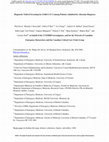
ObjectivesTo determine the diagnostic yield of screening patients for SARS-CoV-2 who were admitte... more ObjectivesTo determine the diagnostic yield of screening patients for SARS-CoV-2 who were admitted with a diagnosis unrelated to COVID-19, and identify risk factors for positive tests.DesignCohort from the Canadian COVID-19 Emergency Department Rapid Response Network (CCEDRRN) registrySetting30 acute care hospitals across CanadaParticipantsPatients hospitalized for non-COVID-19 related diagnoses who were tested for severe acute respiratory syndrome coronavirus 2 (SARS-CoV-2) between March 1, and December 29, 2020Main outcomePositive nucleic acid amplification test (NAAT) for SARS-CoV-2Outcome measureDiagnostic yieldResultsWe enrolled 15,690 consecutive eligible adults who were admitted to hospital without clinically suspected COVID-19. Among these patients, 122 tested positive for COVID-19, resulting in a diagnostic yield of 0.8% (95% CI 0.64% – 0.92%). Factors associated with a positive test included presence of a fever, being a healthcare worker, having a positive household contac...
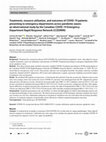
ABSTRACTBackgroundTreatment strategies for coronavirus disease 2019 (COVID-19) evolved between pa... more ABSTRACTBackgroundTreatment strategies for coronavirus disease 2019 (COVID-19) evolved between pandemic waves. Our objective was to compare treatments, acute care resource utilization, and outcomes of COVID-19 patients presenting to Emergency Departments across two pandemic waves.MethodsThis observational study enrolled consecutive eligible COVID-19 patients presenting to 46 Emergency Departments participating in the Canadian COVID-19 Emergency Department Rapid Response Network (CCEDRRN) between March 1 and December 31, 2020. We collected data by retrospective chart review. Our primary outcome was in-hospital mortality. We used logistic regression modeling to assess the impact of pandemic wave on outcomes.ResultsWe enrolled 9,967 patients in 8 provinces, 3,336 from the first and 6,631 from the second wave. Patients in the second wave were younger, fewer met criteria for severe COVID-19, and more were discharged from the Emergency Department. Adjusted for patient characteristics and ...
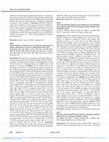
CJEM, 2020
Introduction: Frequent users to emergency departments (EDs) are a diverse group of patients with ... more Introduction: Frequent users to emergency departments (EDs) are a diverse group of patients with a disproportionate number of ED presentations. This study aimed to compare sociodemographic and clinical characteristics of adult high system users (HSUs) and control groups in two provinces. Methods: Cohorts of HSUs were created for Alberta and Ontario by identifying the patients with the top 10% of ED presentations in the National Ambulatory Care Reporting System during April 2015 to March 2016. Random samples of patients not in the HSU groups were selected in each province as controls (4:1 ratio). Sociodemographic and presentation data (e.g., Canadian Triage and Acuity Scale [CTAS], disposition) were extracted and compared using separate logistic regression models. Results: In Alberta, 101,250 HSU patients made 686,918 ED presentations (median [med] = 5 interquartile range [IQR] 4,7 presentations per patient), compared with 401,923 controls who made 560,765 ED presentations (med = 1 I...
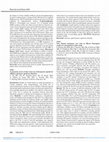
CJEM, 2020
Introduction: Emergency care serves as an important health resource for First Nations (FN) person... more Introduction: Emergency care serves as an important health resource for First Nations (FN) persons. Previous reporting shows that FN persons visit emergency departments at almost double the rate of non-FN persons. Working collaboratively with FN partners, academic researchers and health authority staff, the objective of this study is to investigate FN emergency care patient visit statistics in Alberta over a five year period. Methods: Through a population-based retrospective cohort study for the period from April 1, 2012 to March 31, 2017, patient demographics and emergency care visit characteristics for status FN patients in Alberta were analyzed and compared to non-FN statistics. Frequencies and percentages (%) describe patients and visits by categorical variables (e.g., Canadian Triage Acuity Scale (CTAS)). Means and standard deviations (medians and interquartile ranges (IQR)) describe continuous variables (e.g., distances) as appropriate for the data distribution. These descript...









Uploads
Papers by Rhonda Rosychuk